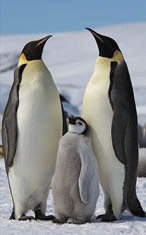

 Penguins have gotten a lot of attention recently. Most of us have seen the wildlife pictures of emperor penguins rocketing out of the sea to the safety of an ice floe to avoid being eaten by a leopard seal. The problem is that when the speed of the penguin through the water is measured, it cannot go any faster than nine feet a second or about six miles an hour. There is no way at such a slow speed that the emperor penguins could come rocketing out the water as they do. The question is then, “How do the penguins do this when they would have to triple their fastest measured speed to come completely out of the water in the jump to safety.”
Penguins have gotten a lot of attention recently. Most of us have seen the wildlife pictures of emperor penguins rocketing out of the sea to the safety of an ice floe to avoid being eaten by a leopard seal. The problem is that when the speed of the penguin through the water is measured, it cannot go any faster than nine feet a second or about six miles an hour. There is no way at such a slow speed that the emperor penguins could come rocketing out the water as they do. The question is then, “How do the penguins do this when they would have to triple their fastest measured speed to come completely out of the water in the jump to safety.”
The answer to this mystery is that the penguins build a bubble slide. Penguins have a dense uniform coat of feathers, and like any bird they can fluff the feathers up to insulate their body with trapped air. In the case of the penguins, the base of their feathers includes tiny filaments just 20 microns in diameter — less than half the diameter of a human hair. Air trapped in the fine mesh of this hair can be released as microbubbles which form a lubricating coat on the feather surface. These bubbles reduce the density and viscosity of the water and lubricate the penguins body. This cuts drag and enables the penguin to reach the speeds that let it escape from the sea and on to the ice floe.
The military and the ship builders are trying to mimic this air lubrication system. In 2010 a Dutch company began selling systems that lubricate ships with bubbles. Romans 1:20 tells us that we can know there is a God through the things he has made. Apparently we can also know how to build better ships that travel more cheaply by imitating God’s methods. Source: National Geographic, November 2012, page 60.
Picture credits:
http://en.wikipedia.org/wiki/File:Aptenodytes_forsteri_-Snow_Hill_Island,_Antarctica_-adults_and_juvenile-8.jpg
